Abstract
Movements of the receptors of concanavalin A on various parts of the surfaces of substrate-attached cells were compared. Cultured mouse embryo cells of several types were used: epithelial kidney cells and normal and transformed fibroblasts. Initial distribution of receptors was random on the cells of all types. Binding of concanavalin A induced patching of its receptors on all the cell parts. In contrast, directional centripetal movement of receptors was observed only on the surface of certain cell parts, namely, only the surface of peripheral lamellar cytoplasm was cleared of the receptors. Clearing was always initiated in the zone of lamellar cytoplasm located near active cell edges. In epithelial sheets, clearing was not observed on the surface of central cells that had no lamellar cytoplasm. Concanavalin A receptors on the cleared areas of cell surface were gradually restored after the end of incubation. It is suggested that anchoring of the patches of membrane receptors by cortical microfilaments is possible only on the surface of pseudopods and of lamellar cytoplasm but not on the surface of other cell parts. Besides receptor movements, this hypothesis may be explain differences in the adhesive properties of various parts of the cell surface.
Full text
PDF




Images in this article
Selected References
These references are in PubMed. This may not be the complete list of references from this article.
- Abercrombie M., Heaysman J. E., Pegrum S. M. Locomotion of fibroblasts in culture. V. Surface marking with concanavalin A. Exp Cell Res. 1972 Aug;73(2):536–539. doi: 10.1016/0014-4827(72)90090-0. [DOI] [PubMed] [Google Scholar]
- Avrameas S. Coupling of enzymes to proteins with glutaraldehyde. Use of the conjugates for the detection of antigens and antibodies. Immunochemistry. 1969 Jan;6(1):43–52. doi: 10.1016/0019-2791(69)90177-3. [DOI] [PubMed] [Google Scholar]
- BAUMSTARK J. S., LAFFIN R. J., BARDAWIL W. A. A PREPARATIVE METHOD FOR THE SEPARATION OF 7S GAMMA GLOBULIN FROM HUMAN SERUM. Arch Biochem Biophys. 1964 Dec;108:514–522. doi: 10.1016/0003-9861(64)90436-9. [DOI] [PubMed] [Google Scholar]
- Bragina E. E., Vasiliev J. M., Gelfand I. M. Formation of bundles of microfilaments during spreading of fibroblasts on the substrate. Exp Cell Res. 1976 Feb;97(2):241–248. doi: 10.1016/0014-4827(76)90613-3. [DOI] [PubMed] [Google Scholar]
- DiPasquale A., Bell P. B., Jr The upper cell surface: its inability to support active cell movement in culture. J Cell Biol. 1974 Jul;62(1):198–214. doi: 10.1083/jcb.62.1.198. [DOI] [PMC free article] [PubMed] [Google Scholar]
- Domnina L. V., Ivanova O. Y., Margolis L. B., Olshevskaja L. V., Rovensky Y. A., Vasiliev J. M., Gelfand I. M. Defective formation of the lamellar cytoplasm by neoplastic fibroblasts (L cells-transformed cells-cell attachment-contact inhibition-scanning electron microscopy-microcinematography). Proc Natl Acad Sci U S A. 1972 Jan;69(1):248–252. doi: 10.1073/pnas.69.1.248. [DOI] [PMC free article] [PubMed] [Google Scholar]
- Edelman G. M., Yahara I. Temperature-sensitive changes in surface modulating assemblies of fibroblasts transformed by mutants of Rous sarcoma virus. Proc Natl Acad Sci U S A. 1976 Jun;73(6):2047–2051. doi: 10.1073/pnas.73.6.2047. [DOI] [PMC free article] [PubMed] [Google Scholar]
- Edidin M., Weiss A. Antigen cap formation in cultured fibroblasts: a reflection of membrane fluidity and of cell motility. Proc Natl Acad Sci U S A. 1972 Sep;69(9):2456–2459. doi: 10.1073/pnas.69.9.2456. [DOI] [PMC free article] [PubMed] [Google Scholar]
- Loor F., Forni L., Pernis B. The dynamic state of the lymphocyte membrane. Factors affecting the distribution and turnover of surface immunoglobulins. Eur J Immunol. 1972 Jun;2(3):203–212. doi: 10.1002/eji.1830020304. [DOI] [PubMed] [Google Scholar]
- Nicolson G. L. Temperature-dependent mobility of concanavalin A sites on tumour cell surfaces. Nat New Biol. 1973 Jun 13;243(128):218–220. doi: 10.1038/newbio243218a0. [DOI] [PubMed] [Google Scholar]
- Nicolson G. L. Trans-membrane control of the receptors on normal and tumor cells. II. Surface changes associated with transformation and malignancy. Biochim Biophys Acta. 1976 Apr 30;458(1):1–72. doi: 10.1016/0304-419x(76)90014-7. [DOI] [PubMed] [Google Scholar]
- Rowlatt C., Wicker R. Concanavalin A binding material derived from a tissue culture medium. J Ultrastruct Res. 1972 Jul;40(1):145–151. doi: 10.1016/s0022-5320(72)80028-5. [DOI] [PubMed] [Google Scholar]
- Ukena T. E., Borysenko J. Z., Karnovsky M. J., Berlin R. D. Effects of colchicine, cytochalasin B, and 2-deoxyglucose on the topographical organization of surface-bound concanavalin A in normal and transformed fibroblasts. J Cell Biol. 1974 Apr;61(1):70–82. doi: 10.1083/jcb.61.1.70. [DOI] [PMC free article] [PubMed] [Google Scholar]
- Vasiliev J. M., Gelfand I. M., Domnina L. V., Zacharova O. S., Ljubimov A. V. Contact inhibition of phagocytosis in epithelial sheets: alterations of cell surface properties induced by cell-cell contacts. Proc Natl Acad Sci U S A. 1975 Feb;72(2):719–722. doi: 10.1073/pnas.72.2.719. [DOI] [PMC free article] [PubMed] [Google Scholar]
- de Petris S. Concanavalin A receptors, immunoglobulins, and theta antigen of the lymphocyte surface. Interactions with concanavalin A and with Cytoplasmic structures. J Cell Biol. 1975 Apr;65(1):123–146. doi: 10.1083/jcb.65.1.123. [DOI] [PMC free article] [PubMed] [Google Scholar]
- de Petris S., Raff M. C. Fluidity of the plasma membrane and its implications for cell movement. Ciba Found Symp. 1973;14:27–52. doi: 10.1002/9780470719978.ch3. [DOI] [PubMed] [Google Scholar]



